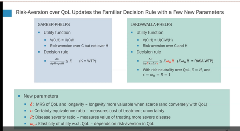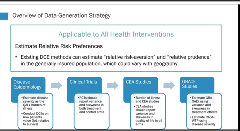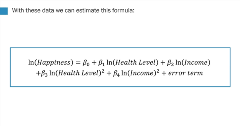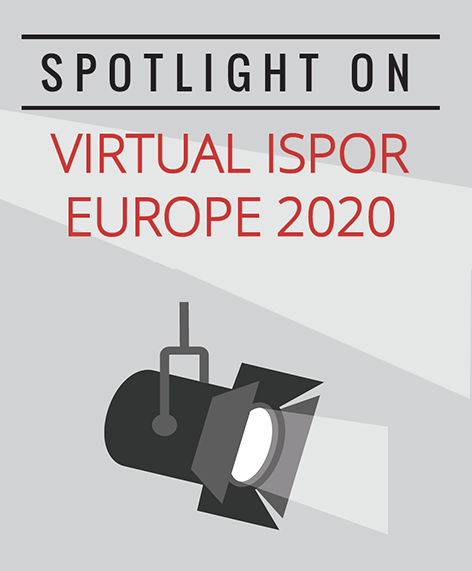Hot off the Production Line! The New Generalized Risk Adjusted Cost-Effectiveness (GRACE) Model
Cate Bailey, PhD, MApSci, BA, Monash University, Melbourne, Australia; and Ingrid Cox, MD, MSc, Dip, University of Tasmania, Hobart, Australia
This interactive session introduced the Generalized Risk Adjusted Cost-Effectiveness (GRACE) Model, a proposed new methodology which introduces risk and risk aversion into traditional cost-effectiveness analysis (CEA) models. This model has been developed by the two presenters and was introduced by Darius N. Lakdawalla, PhD, Leonard D. Schaeffer Center for Health Policy and Economics, University of Southern California, Los Angeles, CA, USA (Figure 1).
Figure 1. Panelists: (L-R) Professors Charles Phelps and Darius Lakdawalla. 
When treating severe illness, it can be difficult for policy makers and decision makers to implement cost-effectiveness decisions. For example, the Cancer Drugs Fund in the United Kingdom was created to pay for cancer drugs that are not cost-effective according to generally accepted threshold criteria. Through this fund, reimbursement takes place despite the high ICER. This situation calls for a new approach to value assessment. Lakdawalla stated that, “If our economic models can’t account for the value of medical treatment to the most severe and vulnerable patients, that’s a problem for the theory.”
The authors of this model stated that traditional CEA doesn’t work from a mathematical perspective, as it is inconsistent with consumer preferences. So, the point is not to make the analysis fancier, but to make it work from a mathematical standpoint. Disparate approaches have been proposed to address these issues, and the GRACE model attempts to bring these approaches together to make it work for real world patients.
Within this unified framework for value assessment are 4 main elements: 1) Insurance value, 2) severity of disease, 3) the value of hope, and, 4) a reduction of uncertainty. All these can all be expressed using a mathematically rigorous framework that incorporates all the traditional elements of CEA.
“If our economic models can’t account for the value of medical treatment to the most severe and vulnerable patients, that’s a problem for the theory.”—Darius N. Lakdawalla, PhD
Insurance Value
How much would sick people pay for treating their illness compared to how much should healthy people pay, given that payments (insurance/taxes) come from people who are not being treated? These two questions have different answers, as for a healthy person, illness is a risk, not a condition. There is value in insurance through lowered anxiety about the future, but we ignore this value in CEA. By ignoring insurance value, effects are under-reported and this is why CEA for rare diseases is often put aside.
Value of Hope
Studies generally use median survival rates between treatment and comparator, but is it important to assess how much patients care about the percentage of patients still alive over the longer term? Studies have found that patients are likely to gamble on being the “lucky patient” even if this contains the risk of an earlier death.
The GRACE model addresses the need for a unified framework to bring overlapping elements together without double counting. It is a micro-economic framework that incorporates the diminishing returns assumption, alongside risk aversion of quality of life (QoL), and can be used in a similar way to traditional CEA. The GRACE model adjusts QoL for insurance value and the value of hope and incorporates revised cost-effectiveness thresholds that change in relation to the severity of the disease. Context matters, a QALY is not always a QALY.
“When should you use GRACE instead of CEA? Whenever you prefer correct answers to incorrect ones.”—Charles Phelps, PhD
Charles Phelps, PhD, Economics, Public Health Sciences, University of Rochester, GUALALA, CA, USA, provided an overview of the mathematics underpinning the GRACE model. He started with outlining the first formal justification of CEA from 1997 (Garber and Phelps) and reminded the audience that this model implicitly assumed risk neutrality, and cited this as a restriction. The key implications of this were: cost effectiveness thresholds were insensitive to disease severity; median income was twice the per capita GDP; the value of QoL gains were independent of baseline QoL, disease severity or disability; and value of survival gains were independent of baseline survival. The ingenuity of the GRACE model is that it introduces risk and risk aversion into the traditional framework, allows for uncertain health in future periods and treatment outcomes, introduces risk aversion over QoL and unifies value of hope, insurance value disease severity, uncertainty and other risk related “petals” of the ISPOR task force “value flower.”
Figure 2. Garber Phelps CEA model vs. new Lakdawalla-Phelps (GRACE) model with illustration of the new model parameters.

Phelps then presented the new equation for GRACE (Figure 2) and reviewed some of the parameters. In the first instance, he focused on estimating the relative risk preferences (Figure 3). He then proposed two methods to estimate the risk aversion for the QoL, method 1, using DCEs and method 2, using the happiness measurement (Figure 4). Existing literature measures consumer happiness directly and this can be applied to measure risk aversion over QoL.
Figure 3. Estimation of relative risk preferences.

He presented a poll to show how easily happiness measurement data can be gathered using surveys, using polls for happiness, QoL, and family income. He then briefly expanded on measuring the 𝞭, the marginal rate of substitution between survival and QoL.
Figure 4. Estimation of the happiness measurement.
Phelps concluded by emphasizing the benefits of using the GRACE model. The model improves estimates for models that address severe diseases or permanent disability, it produces more modest mean treatment benefits, it involves more variable outcomes and it is more important when risk aversion over QoL is greater. He managed expectations by mentioning that developing the model was a process and would first have to be accepted and promoted by manufacturers and payers. This would only be achieved through a larger body of evidence. He encouraged payers to use the method to establish and publish disease specific cost effectiveness thresholds, estimates of preference for relative risk bearing and trade-off between survival and QoL. Payers can then choose their own estimates or decide to set uniform standards.
In conclusion, according to the panelists, GRACE is a novel way to improve current shortcomings of the traditional CEA model but there are still hurdles to overcome before it is accepted and implemented. Getting buy-in and acceptance from manufacturers and payers will be the first step.


